- California Assembly OKs highest minimum wage in nation
- S. Korea unveils first graphic cigarette warnings
- US joins with South Korea, Japan in bid to deter North Korea
- LPGA golfer Chun In-gee finally back in action
- S. Korea won’t be top seed in final World Cup qualification round
- US men’s soccer misses 2nd straight Olympics
- US back on track in qualifying with 4-0 win over Guatemala
- High-intensity workout injuries spawn cottage industry
- CDC expands range of Zika mosquitoes into parts of Northeast
- Who knew? ‘The Walking Dead’ is helping families connect
Seoulites, foreigners celebrate hanbok in splendor
SEOUL, Sept. 23 (Yonhap) — A three-day festival kicked off in Seoul Friday to celebrate the beauty and culture of Korea’s traditional dress — the hanbok — drawing hundreds of visitors and participants from around the world.
The inaugural event, named “2016 Jongno Hanbok Festival,” aims to promote Korea’s rich traditional culture and especially its hanbok through various opportunities to see, wear and walk around in the colorful clothing.
Events are being held across the historical ward of Jongno — from Gwanghwamun Plaza and Insadong to Bukchon and Mugyewon — enhancing the traditional feel of the festival. Jongno is home to many of the country’s largest palaces, including Gyeongbok Palace and Changdeok Palace.
The opening ceremony on Gwanghwamun Plaza was packed with visitors and dignitaries — men and women, young and old — as the head of Jongno Ward declared the festival’s launch.
“Hanbok is part of our unique traditional culture, which has long reflected the customs of our lives and which we must cultivate with care,” Kim Young-jong, dressed in a light blue hanbok, said in his congratulatory remarks. “Starting with this festival, I hope you will be able to discover the grace and beauty of hanbok that were previously unknown to you.”
Officials said Jongno plans to turn the festival into one of the country’s leading cultural events as part of a wider campaign to spread traditional Korean culture, including hanok, or Korean houses, Hangeul, the Korean language and hansik, or Korean food.
Highlights of the three-day event so far include a reenactment of a royal wedding from the Joseon Dynasty (1392-1910) and demonstrations of the traditional Korean dance “ganggangsullae.” The reenactment was performed by students of the Pungmoon Girls’ High School, which is located on the site of a former palace annex, while the ganggangsullae was danced in a circle, as per tradition, by both professionals and anyone who wished to take part.
Running throughout the festival are hanbok exhibitions and fashion shows, with a Korean food market, a traditional market, and Korean tightrope walking and mask dances on the sidelines.
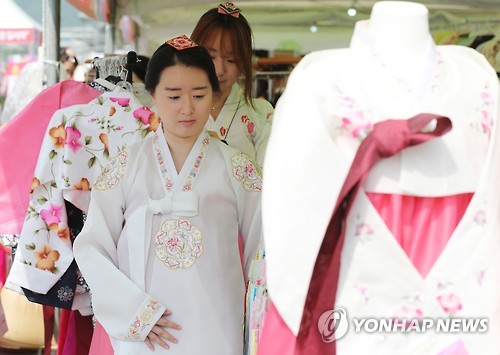
Two girls try on hanbok during the “2016 Jongno Hanbok Festival” on Gwanghwamun Plaza in Seoul on Sept. 23, 2016.
Maria Montiel Ocampo, an exchange student from Mexico, was dressed in a hanbok made up of a golden skirt and a pale yellow top as she watched the opening ceremony.
“I think it’s really interesting to actually see this culture and how Koreans used to dress a long time ago. I really like it,” she said.
Her boyfriend, who is visiting her from Mexico, stood next to her in a matching hanbok of pale yellow and purple hues.
“I like it because I think it’s so elegant and fancy. When I walk through the palace wearing the hanbok I feel like a royal. It’s so elegant,” said Julian Gastellou Durand.
The pair had borrowed the costumes from a stall on the plaza that rented out the dresses for 5,000 won (US$4.50) for four hours or 8,000 won for eight hours.
After walking around in the hanbok for nearly three hours, both said it was “really hot.”
But the festival itself, Durand said, was “just wonderful.”
“I think it’s wonderful because so far we only have seen the modern part of Korea, which is awesome. (Now) we get a chance to get in touch with the traditional Korea, so I think you should do this more,” he added.
To promote hanbok, the ward office has prepared various discounts and benefits for those who wear it.
During the festival period, hanbok wearers will be able to enter Gyeongbok Palace, Changdeok Palace and Changgyeong Palace for free, while more than 100 restaurants in the area will offer them a 10 percent discount on their food.
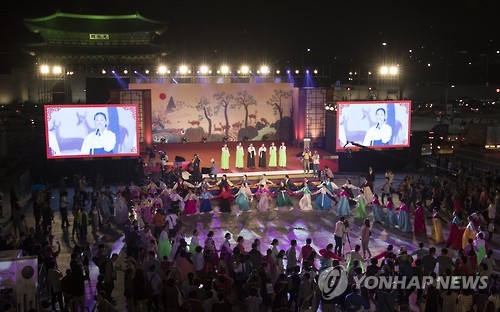
The traditional Korean dance, ganggangsullae, is performed on Gwanghwamun Plaza in Seoul on Sept. 23, 2016.
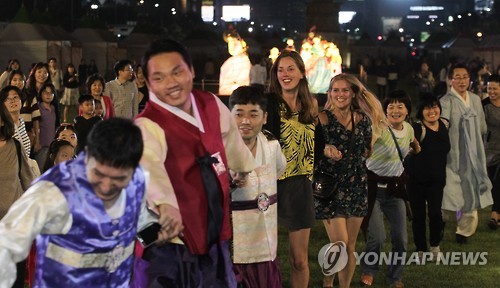
The traditional Korean dance, ganggangsullae, is performed on Gwanghwamun Plaza in Seoul on Sept. 23, 2016.







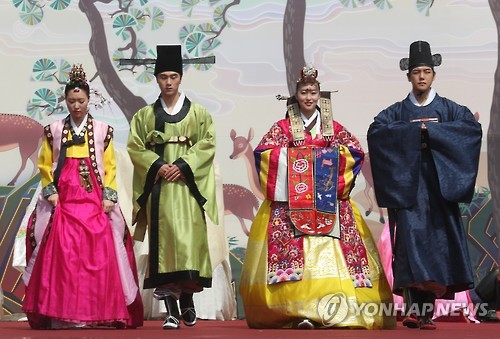
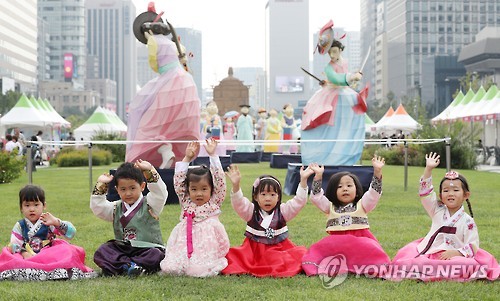


![일본 사도광산 [서경덕 교수 제공. 재판매 및 DB 금지]](http://www.koreatimesus.com/wp-content/uploads/2024/07/PYH2024072610800050400_P4-copy-120x134.jpg)


